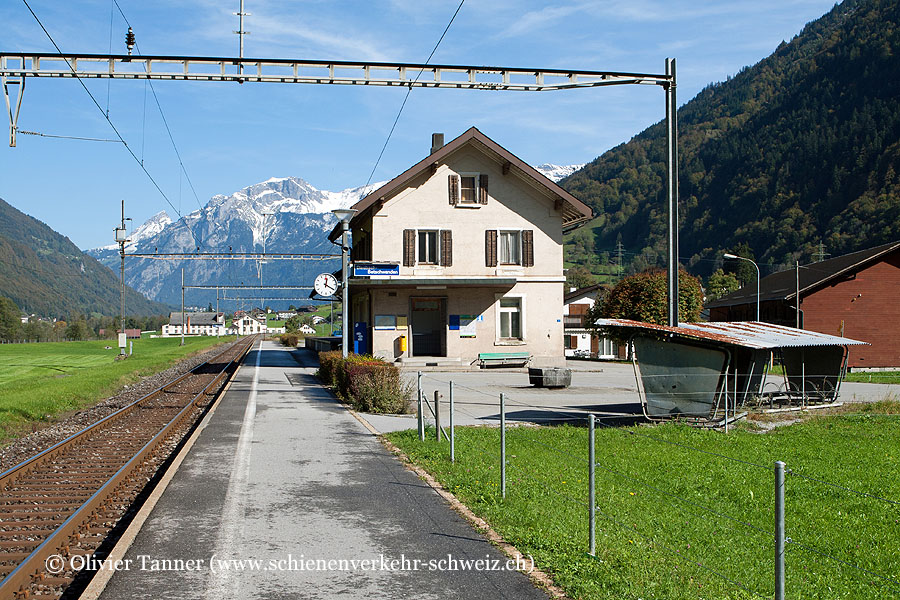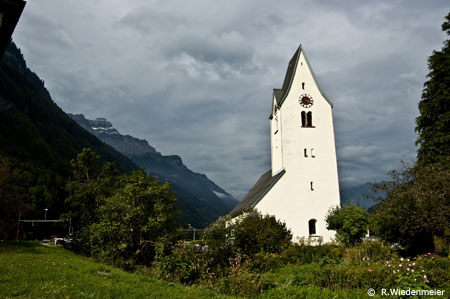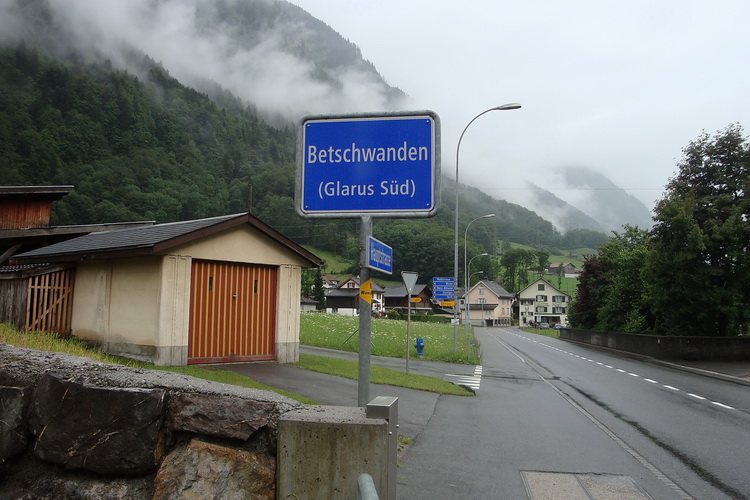Betschwanden
Betschwanden ( in local dialect: [ b̥etʃʋɑnd ( ə ) ] ) is a village in the municipality of Glarus Süd in the Swiss canton of Glarus.
Geography
The village center of Betschwanden is on the right side of the Glarus Grosstals, a few kilometers north of Linthal, on the alluvial fan of this Bach 600 m above sea level.. M. The largest part of the former municipality is made from the mountainous terrain of Freiberg Kärpf; of the total of 974 hectares, about half (501 ha) of agricultural land, about a quarter (247 ha) is forest and pastureland. The climate is alpine.
History
The oldest surviving mention of the name dates back to a document from the year 1240: decimam in Beswando; 1436 he appears as bed walls. It is likely to be a composite of the Old High German personal name Betto / Petto and the base word OHG * swanta, MHG Swant, denoting the Schwendbau, a widespread especially in Almwirtschaftsbereich form of clearing,.
In Betschwanden lived from 1532 to 1555 the Glarus reformer Fridolin Brunner. Under the influence Brunner sat Betschwanden 1533 as the first community Glarus an independent municipality and church care a.
From the 16th to the 18th century, this Bach, Hätzingen and Haslen belonged to Tagwen Betschwanden who scored a total of 222 adult male compatriots in 1700. The connection with Hätzingen, this creek and Ruti extends today to the Reformed parish ( until 1942 also Braunwald ).
The Political Betschwanden community has risen to the beginning of 2011 as a result of the Glarus municipality reform in the new municipality of Glarus Süd.
Population
The community Betschwanden was measured at the Bevölkerungeszahl next Leuggelbach the smallest municipality in the canton. She scored 2007 only 191 inhabitants, not much more than the end of the 17th century (1692: 123 people). In 1850 we had 254 people registered in the community, a hundred years later, around 30 people more.
Economy
And Alpine farming were to the 19th century, the main source of income Betschwander: The Alp front sand, which now in the middle of the municipality of Linthal is owned by the Tagwen for centuries. From a 1843 spinning mill was opened in 1910, a warehouse, 1982, a textile chemical company. Today, many Betschwander are commuters and work in the country under the direction of Zurich.
Natural Hazards
Before the Limmer Reservoir, the power plants Linth Limmeren was built in 1963, the Lindth was an unpredictable mountain river that threatened wash away more than once in the villages Grosstal. In the avalanche winter of 1951 (January 20 ) broke throughout the length of the Kneugrathanges going on an avalanche that destroyed not only seven stables and two cottages, but also two people lost their lives. As a result, the avalanche area were mounted on Kneugrat and reforested, which reduces the risk of further Katatstrophen.
Traffic
The north to the cantonal capital, and to the south over Linthal Urnerboden and the Klausen Pass the Reuss valley leading main road ( main road 17 ) is the main road link. Since 1879 Betschwanden is connected to the network of the Northeastern Railway ( Station This Bach Betschwanden ), another route, which is now run by the Swiss Federal Railways ( Railway replaced late in the evening by a bus ).
Policy
Against all odds Betschwanden has maintained its autonomy. Since 1 January 2000, there is a unified community. The municipality was merged with the school and the community welfare. Exist with the communities especially the southern Great Tales agreements and special-purpose associations for over municipal solving tasks (management, etc.).
Train
The little ones go with a school bus to Linthal to kindergarten. The first graders also go to Linthal to school. The primary school (3rd - 5th grade) divides Betschwanden with Ruti, where the school house stands. The high schools are in Linthal ( Sekundar-/Oberschule ), in Luchsingen (Realschule ) or in the main town of Glarus ( canton school).
Attractions
The church Betschwanden is one of the most important monuments in the canton of Glarus. It was built in the 12th century in the Romanesque style and is one of the largest Romanesque buildings north of the Alps dar. 1779-1780 built the community a dam - the " Kirchwuhr " - the church, to protect them before the flood of Linth. In 1915 she received art nouveau and neo-baroque elements. 1975-1977 it was restored and in 2001 the last time subjected to exterior renovations. The church is now used for concerts.
- Village with the village well ( since 1855 here standing)
- This Bach case - one of the last waterfalls in the Glarus region, that has not fallen victim to the electricity industry (yet). Its name comes from " this ", the roaring noise especially at the time of snowmelt.
- The mill was built in 1778 on this stream, the guest house of the parish.
Personalities
- Christoph Zellweger, Old Hippie, politicians and entrepreneurs










